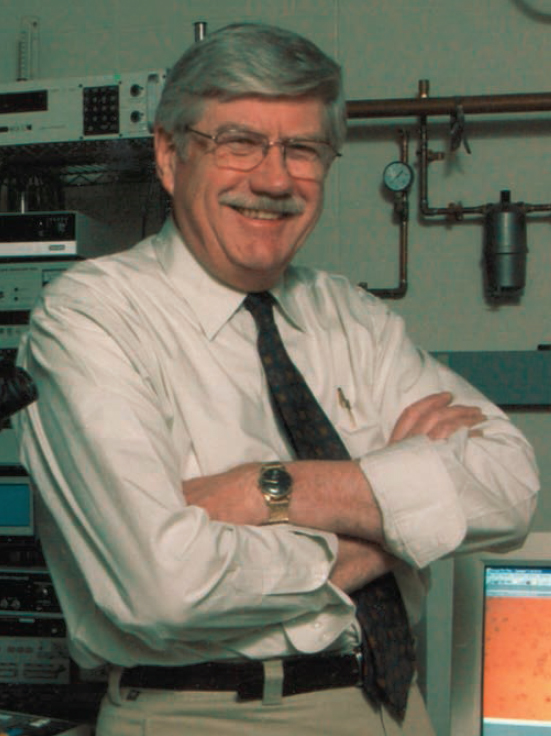
PETER G. SIMPKINS
1934–2016
Elected in 1999
“For contributions to the understanding and development of processes fundamental to the manufacture of low-loss, high-strength optical fiber.”
BY DAVID W. JOHNSON JR. AND ROGER L. McCARTHY
PETER GERALD SIMPKINS, a guiding force at Bell Laboratories in fundamental fluid mechanics, fracture mechanics, and development of the associated instrumentation for transparent fluids and solids, passed away June 20, 2016, at the age of 81. His pioneering work made dramatic improvements in the manufacture of optical fibers that are now the backbone of the internet.
Peter was born November 28, 1934, in London and started his higher education at London University, where he earned a diploma technology (aero engineering) in 1957. He went on to earn a diploma at the von Karman Institute in Brussels in 1959 and an MS in aeronautics (1960) at the California Institute of Technology. He then returned to London and attended Imperial College, where he was awarded the diploma in 1963 and a PhD (aeronautics) in 1965. While doing his undergraduate work he was also an engineering apprentice at HandleyPage Aircraft Co. and, as a graduate student at Imperial College, worked as a research assistant (1960–65).
He began his career in 1965 as a consultant staff scientist at AVCO Corporation in Wilmington, Massachusetts, until he was hired as a member of the technical staff at Bell Laboratories in Whippany, New Jersey, in 1968. He became a US citizen in 1973 and, except for a brief stint as a senior research fellow at the University of Southampton, England (1973–74), spent
the remainder of his career at Bell Laboratories. He moved to Murray Hill in 1974 when he joined the Labs’ basic research area, and in 1983 was promoted to distinguished member of the technical staff.
Peter was a highly respected researcher and collaborator at Bell Laboratories. He made important contributions to understanding of the mechanical properties of optical fibers and the source of strength degrading flaws. Using his knowledge of fluid dynamics, he made advances in processes to effectively coat fibers with polymers to protect the fiber surface from damage. He was an important contributor to the understanding of the modified chemical vapor deposition (MCVD) process that AT&T developed for manufacturing fibers. For this program, he again used his fluid dynamics background to recognize that thermophoresis was the driving force to deposit high-purity silica particles on the inside of substrate tubes. His breadth of knowledge of fundamental processes allowed him to contribute to many other advances in areas such as metal melting and casting, drying of sol-gel silica structures, and thermal characterization of multichip modules.
He authored more than 60 technical publications and was awarded six patents.
After his election in 1999 to the National Academy of Engineering, Peter spent the next decade heavily involved in various Section 10 (Mechanical Engineering) committees and leadership. His dry wit, self-effacing understatement, and wise insights endeared him to all his colleagues.
His advice and insights were regularly sought by the National Aeronautics and Space Administration, where he studied problems associated with missile and rocket reentry to provide American astronauts a safe return. He served on the agency’s Spacelab 3 Science Board (1978–80), Fluids and Chemical Processes Review Board (1978–80), Materials Processing in Space Review Panel (1980–81), and Interface Dynamics and Stability Review Panel (1992).
Always helping those in his profession, after his election as a fellow of the American Society of Mechanical Engineers (ASME) he served on the Environmental Heat Transfer
Committee (1983–93), Fluid Mechanics Committee (1986–95), Heat Transfer Honors and Awards Committee (1994–96), Heat Transfer Visualization Committee (1992–97), Long Range Directions and Issues in Heat Transfer Committee (1998–2001), and Theory and Fundamental Research Committee (1992 until his passing). He was also elected a fellow of the American Physical Society in 2010 in recognition of his work in fluid mechanics.
He was associate technical editor for Transactions of the ASME Journal of Heat Transfer (1995–98) and technical referee for various National Science Foundation programs and for NATO Advanced Study Institutes. He was a NATO fellow in 1959.
Peter was active in educating the next generation of engineers. At the time of his passing he was an adjunct professor of chemical engineering at Lehigh University, as he had been for the previous 28 years. And from 2002 to 2007 he taught and advised graduate students as a University Professor at Syracuse University’s L.C. Smith College of Engineering and Computer Science. He started his practice of mentoring and educating as a lecturer at Northern Polytechnic in London (1960–64) after getting his master’s and as a lecturer at Northeastern University (1965–68). As a history buff and self-proclaimed Renaissance man, he included social sciences and literature in his curriculum to give students a sense of the evolution of mathematics, physics, and engineering.
Among his personal interests and pursuits were stamp collecting, painting, photography, tennis, and bird watching. In addition, he was an avid fisherman for over 40 years and spent summer holidays with his wife, children, and grandchildren at Loon Lake Lodge in Ontario. His passion for fishing would inevitably lead to a lesson on fishing tips and tactics, and on occasion he would challenge them to catch a larger walleye than he. During the early summer months his love of hummingbirds would reemerge; he spent many hours relaxing on his deck taking photos of these small creatures when they came to visit him.
Peter loved all opportunities to get together with his daughters and grandchildren, watching them participate in
sporting events and school plays or sharing with them another of his passions, eating oysters.
He and his wife, Marion (née Hazell), loved all genres of music and were enthusiastic dancers throughout their life. In their early years together they won the All East England Championship in square dancing.
He is survived by Marion; daughters Tracy, Lisa, and Fiona; and five grandchildren.






